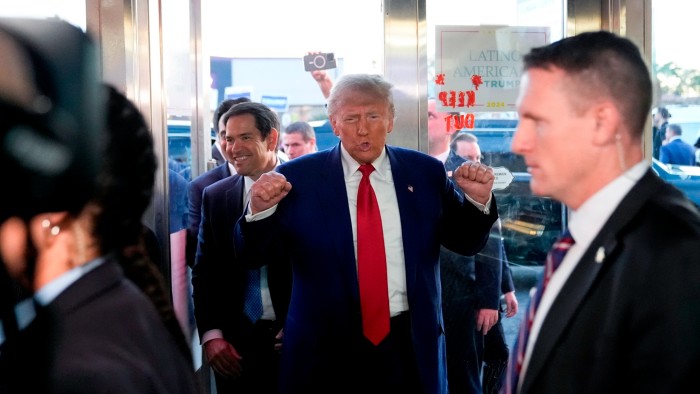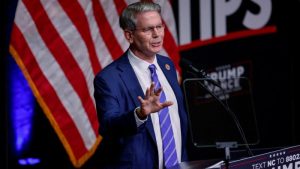Donald Trump’s rubber-stamp government takes shape

Donald Trump has raced to pluck loyalists from the fringes of American politics to fill key jobs — a succession of personnel decisions designed to smooth passage of his agenda and concentrate his power.
The president-elect’s appointments have stunned the political establishment in Washington, triggering outrage among Democrats and bafflement even among some Republicans on Capitol Hill, which could make for tense confirmation votes.
But they meet Trump’s goal: to pre-empt resistance and stack his government with people who will rubber-stamp and execute his radical agenda.
“He personally wants as much power as possible and less checks on him,” said Stephen Myrow, a managing partner at Beacon Policy Advisors, a consultancy in Washington.
“There are particular positions that he’s learned now that he needs to have utter control over,” Myrow added, pointing to the Department of Justice, the military, and the intelligence community.
Within the space of two days, the president-elect has tapped Robert F Kennedy Jr, the anti-vaccination activist, to be health secretary, Tulsi Gabbard, a pro-Russian former Democratic congresswoman, to be director of national intelligence, Pete Hegseth, a Fox News host, to be defence secretary, and Matt Gaetz, a far-right conservative facing a Congressional ethics probe into sexual misconduct, to be attorney-general.
Trump on Thursday evening announced Todd Blanche — the bulldog lawyer who represented him during the “hush money” trial which ended in the former president’s felony conviction — was his pick for deputy attorney-general.
Later, he nominated North Dakota’s governor Doug Burgum to be his secretary of the interior, handing one of his most prominent boosters on the campaign trail influence over licensing for oil and gas drilling.
The common feature of these appointees is their devotion to Trump. Many vigorously campaigned for him in the final stage of the election against vice-president Kamala Harris. Many are beloved by the former president’s current entourage including Elon Musk, the billionaire investor, and his online followers.
The choices mark a contrast with the cabinet that Trump assembled at the start of the first term, which included outside figures and members of the traditional Republican policy establishment — who he eventually blamed for undermining his plans.
His new team also differs from those that other presidents have brought together to deliberately include former opponents or dissenting perspectives.
“This is not going to be a ‘Team of Rivals’,” said Chris Krueger, a managing Director at TD Cowen’s Washington Research Group, a consultancy, referring to historian Doris Kearns Goodwin’s book about Abraham Lincoln’s cabinet.
“It’s a team that shares president Trump’s vision, and can really execute that vision on day one,” Krueger added.
At the same time as Trump has picked some of his most loyal political surrogates for leading cabinet jobs, he is also looking to appoint policy tsars at the White House who will be physically closer to the Oval Office and in charge of directing government action. They could well have more influence than cabinet members in implementing his plans.
Trump has chosen Tom Homan, an immigration hardliner, to be his border tsar. Homan and deputy chief of staff Stephen Miller will be tasked with enacting the president-elect’s planned crackdown on migrants, including mass deportations.
Trump also plans to appoint an energy tsar to scrap regulations and boost fossil fuels.
These senior White House roles will not require Senate approval — but could come with sweeping power to carry out Trump’s plans.
Cabinet appointments do, however, need approval of the upper chamber of Congress. Some Republicans in the Senate, where they will have the majority starting in January, have been caught off guard by some of the nominations — though they seem inclined to give them the benefit of the doubt.
“Generally speaking, I vote for confirmation regardless of party or personal feelings because that is my constitutional role as a Senator,” Lindsey Graham, the Republican South Carolina senator and a close Trump ally, wrote on X on Thursday.
“I will do the same for president Trump’s nominees. The American people have spoken loudly, and president Trump won decisively. I consider this matter closed,” he added.
But there could be some pushback from the small group of moderate and sceptical Republicans, including Susan Collins of Maine.
Myrow said: “Trump expects Republicans in Congress to fully bend the knee, to be in full submission, and so this will be a test.”
Trump has made some conventional choices for his new administration — the kind who might have entered any Republican White House. Those include Marco Rubio, the Florida senator, to be secretary of state, Mike Waltz, the Florida congressman, to be national security adviser, and Jay Clayton, the former chair of the Securities and Exchange Commission, to be US attorney for the southern district of New York.
He also still needs to decide on the top economic policy jobs, ranging from Treasury secretary, to commerce secretary, director of the National Economic Council, and US trade representative.
But the overall picture is that Trump — who has faced multiple criminal investigations and two assassination attempts, and has vowed to take on the “deep state” as a primary focus of his presidency — is looking to place fealty over other considerations.
“The common thread is loyalty,” Krueger said.
#Donald #Trumps #rubberstamp #government #takes #shape




